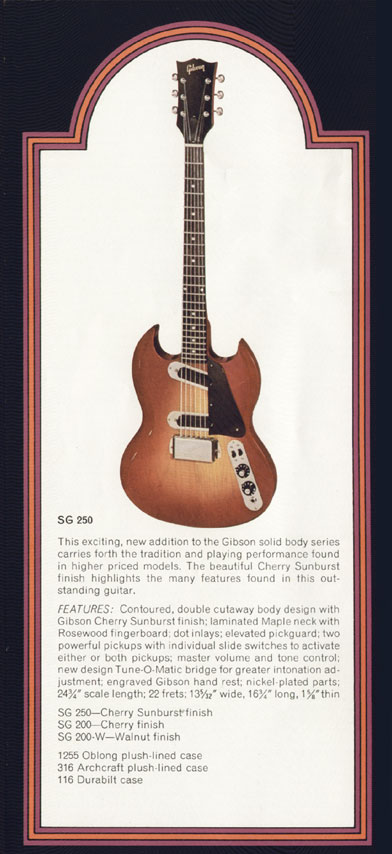

As always with Gibson, there are exceptions - even when not listed, Cherry seems to have been available. Despite these other colour options, the majority of 60s SG Customs are finished White, and the majority of 60s Customs are finished Walnut. The last price-list of the 1970s saw just White and Walnut available, before the SG Custom was discontinued in the 1980s. This was replaced by Cherry for a short time, with Tobacco Sunburst also very briefly listed. This continued until 1975 when both Walnut and White were offered, with Wine Red being added briefly in the June '75 price list. The September 1969 price list is the first to list Walnut as the stock finish. But by the end of the decade, White was dropped in favour of Walnut. The gold hardware stood out against the white body giving this guitar a very flashy appearance. Initially, Gibson only listed white as a finish for the SG Custom, and it is this colour that is most associated with this guitar. It did continue in numerous other Gibsons throughout the 1970s. It was not popular on high end instruments, and was dropped in the SG Custom within a year. This attempt to reduce production costs was being introduced in numerous Gibson solid-body models - it was a time of real crisis for the American guitar industry, with heavy competition from cheaper overseas imports. One big change occurred around 1971/72, when the controls started to be mounted on a semi-circular control plate, rather than (via a back cavity) through the body wood itself (See the 1972 Gibson Solid Bodies catalogue). As the decade wore on, it became very much the Bigsby that was the option. From June 1973, Gibson started advertising the SG Custom with a Bigsby vibrato, or an optional stop tailpiece. Several different versions were used, early examples are fitted with Gibson 'side to side' vibrato, or inlaid ebony block vibrato, followed by the Gibson deluxe (lyre) vibrato, which is probably the best known. The part that changed most noticeably in this model is the tailpiece. See the 1972 Gibson Solid Bodies catalogue SG Custom hardware and componentsĮach of the three humbucking pickups were identical: neck, middle and bridge, and they were the same pickups as used in the SG Standard, ES-175D and numerous other Gibson guitars, though with gold-plated covers. The 1972 Gibson SG Custom was quite different from earlier and later versions. This selected front pickup only, middle and back pickups together, or the back pickup only. Just like the other Gibson SG models, the Custom had two volume and tone controls, and a three way switch. Famous users include: Jimi Hendrix, Buddy Guy, Ollie Halsall, Lenny Kravitz and Sister Rosetta Tharpe - all of whom played white SG Customs. There were some cosmetic changes over the years, but little that stops this guitar from being one of Gibsons most recognizable models. 6346 SG Customs were produced between 19, after which it was dropped from the Gibson price lists and catalogues. Like the other SGs it was mahogany throughout with a set neck.

It was initially a redesigned Les Paul Custom, and was named as such initially.

It had the high-end split-diamond headstock inlay, and mother of pearl block fingerboard markers in an ebony fretboard. The Gibson SG Custom was the top of the Gibson SG range: three Gibson humbuckers, and gold-plated throughout. Having said this, there are a lot worse guitars out there, and as well as being historically important, the 1820 bass can certainly provide the goods when required.Finishes Cherry, White, Walnut, Wine Red, Tobacco Sunburst Over the course of the 70s, the Japanese output improved dramatically, and in many ways these early 70s models are a low point for the brand. These new Epiphones were based on existing Matsumoku guitars, sharing body shapes, and hardware, but the Epiphone line was somewhat upgraded, with inlaid logos and a 2x2 peghead configuration. The Matsumoku factory had been producing guitars for export for some time, but the 1820 bass (alongside a number of guitar models and the 5120 electric acoustic bass) were the first Epiphone models to be made there. By the end of the 1960s, a decision had been made to move Epiphone guitar production from the USA (at the Kalamazoo plant where Gibson guitars were made), to Matsumoto in Japan, creating a line of guitars and basses significantly less expensive than the USA-built models (actually less than half the price).


 0 kommentar(er)
0 kommentar(er)
